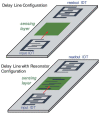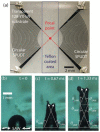Surface Acoustic Wave (SAW) Sensors: Physics, Materials, and Applications
- PMID: 35161565
- PMCID: PMC8839725
- DOI: 10.3390/s22030820
Surface Acoustic Wave (SAW) Sensors: Physics, Materials, and Applications
Abstract
Surface acoustic waves (SAWs) are the guided waves that propagate along the top surface of a material with wave vectors orthogonal to the normal direction to the surface. Based on these waves, SAW sensors are conceptualized by employing piezoelectric crystals where the guided elastodynamic waves are generated through an electromechanical coupling. Electromechanical coupling in both active and passive modes is achieved by integrating interdigitated electrode transducers (IDT) with the piezoelectric crystals. Innovative meta-designs of the periodic IDTs define the functionality and application of SAW sensors. This review article presents the physics of guided surface acoustic waves and the piezoelectric materials used for designing SAW sensors. Then, how the piezoelectric materials and cuts could alter the functionality of the sensors is explained. The article summarizes a few key configurations of the electrodes and respective guidelines for generating different guided wave patterns such that new applications can be foreseen. Finally, the article explores the applications of SAW sensors and their progress in the fields of biomedical, microfluidics, chemical, and mechano-biological applications along with their crucial roles and potential plans for improvements in the long-term future in the field of science and technology.
Keywords: AlN; GaAs; GaN; IDT; Lamb wave; Love wave; MEMS; Rayleigh wave; SAW devices; SAW wave; SH-wave; ZnO; biosensors; chemical sensors; crystal cut; interdigitated electrodes; lithium niobate; lithium tantalate; point-of-care (POC); surface acoustic waves (SAW).
Conflict of interest statement
The authors declare no conflict of interest.
Figures



























References
-
- Fu Y.Q., Luo J.K., Nguyen N.T., Walton A.J., Flewitt A.J., Zu X.T., Li Y., McHale G., Matthews A., Iborra E., et al. Advances in piezoelectric thin films for acoustic biosensors, acoustofluidics and lab-on-chip applications. Prog. Mater. Sci. 2017;89:31–91. doi: 10.1016/j.pmatsci.2017.04.006. - DOI
-
- Kirschner J. Surface Acoustic Wave Sensors (SAWS) Micromech. Syst. 2010;6:1–11.
-
- Mark D., Haeberle S., Roth G., Von Stetten F., Zengerle R. Microfluidics Based Microsystems. Springer; Dordrecht, The Netherlands: 2010. Microfluidic lab-on-a-chip platforms: Requirements, characteristics and applications; pp. 305–376. - PubMed
Publication types
LinkOut - more resources
Full Text Sources
Other Literature Sources

